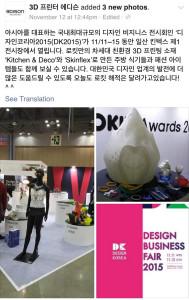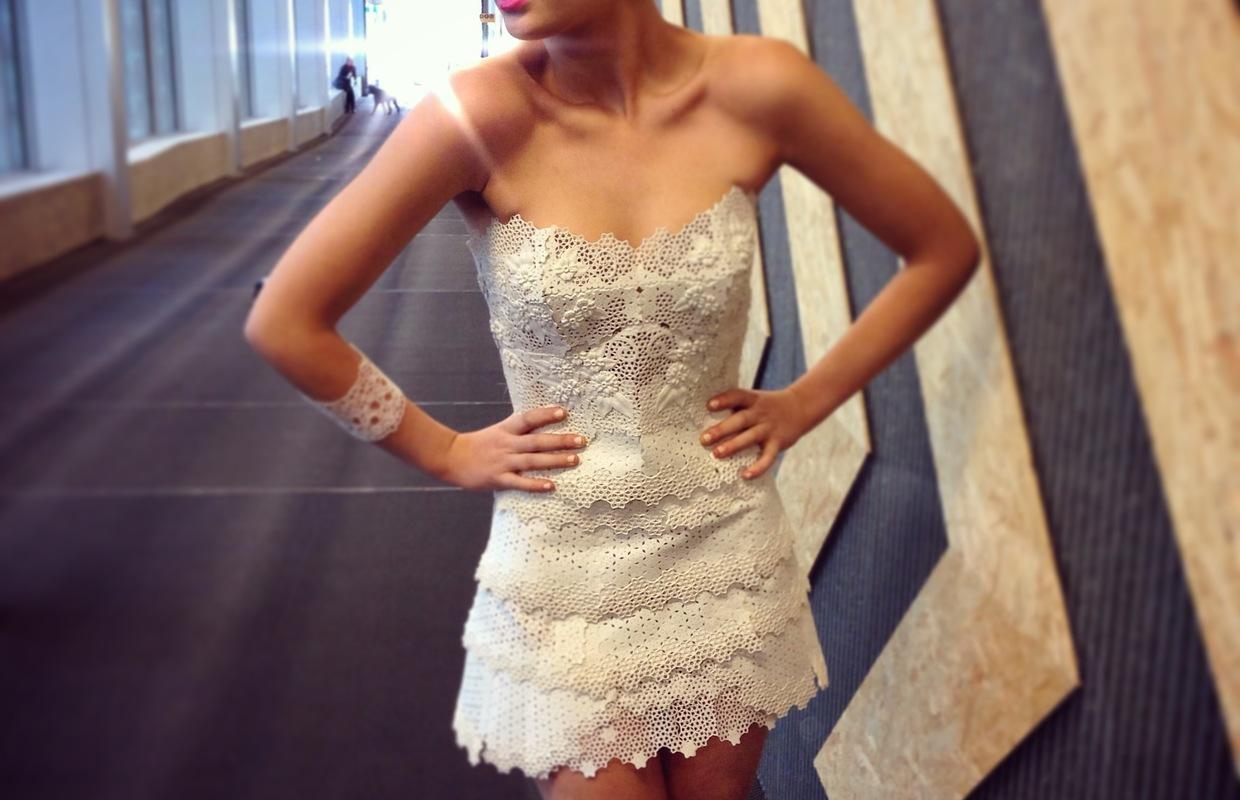It’s not the first time this year a dress has caused controversy (and with Kim Kardashian probably on her way out of maternity wear, probably safe to say it won’t be the last). Designed by the team at XYZ Workshop in 2014, this dress is a stunning coming together between fashion design and 3D printing. The lovely inBloom dress is all innocence in photos, delicately 3D printed in white, bedecked with blooms, and flattering to the form. It was also just the beginning, as the team behind XYZ Workshop, husband-and-wife duo Kae Woei Lim and Elena Low, took their skills further, developing further incredible 3D printed fashion.
We’ve been following the progress from XYZ Workshop for some time now, as they’ve been enhancing their profile in the design arena. They make their designs available for use via Creative Commons Licensing through YouMagine, going so far as to create an Instructables project detailing the construction so you too can have your very own haute couture 3D printed gown.
To this point, the tale is a simple one: designers create beautiful work, make it available for sharing, and enjoy the proliferation of their creation among like-minded makers.
Recently, however, even as intellectual property looms ever larger in the eye of the 3D printing community–with digital files seemingly everywhere on the internet, some causing their own brands of controversy and others simply set to protect patents–we’ve now seen another side of IP infringement: the purportedly accidental.
While piracy exists beyond doubt in every tech arena, most individuals stealing the designs and IP of others are fairly bold about it. Others, however, might fall into the trap of simply not looking deeply enough into designs that happen into their lives–as seems to be the case at hand.
Recently, we took a look at some new materials from South Korea’s ROKIT, which has recently released bio-friendly materials including Skinflex. The materials certainly looked promising, and Skinflex was on display in a finished design (since removed from both our article and ROKIT’s website): a beautiful white 3D printed dress, fitted to the form. More: it was so impressive, it had won an award!
“A dress made of flexible and elastic material called ‘Skinflex’ won the grand prize in 3D printing sector at Design Korea 2015, which was held in South Korea on November 12th, 2015,” ROKIT’s original press release stated.
The dress was one we had seen before, as XYZ Workshop’s Kae Woei wrote in with a worried note:
“Your article took us by [surprise], as we found out that Rokit has been using our very own 3d printed dress design outside the Creative Commons license by not crediting our work and also using it for commercial gain,” he explained. “But what shocked us more was that they had used our design to enter in the korean design competition and won the grand prize pushing our design!”
“I know that designers designs like ours who shares our designs for free with all good intentions, tend to get their designs used and not get credited most of the time,” he told me. “But to find out an individual or business entered a design competition with our design is just unacceptable! People like these give us little motivation to share our designs for free with the community.”
 A flurry of emails ensued, as Kae Woei sought to preserve his company’s design integrity, and I tried to figure out what was going on at all. Talking with ROKIT’s manager of Overseas Business Development Division, Eunji Oh, ultimately we discovered that the truth was somewhat stranger than we might have guessed. While many unscrupulous individuals do indeed take designs without credit, this particular case seemed to result from a series of accidents that led to unintentional infringement.
A flurry of emails ensued, as Kae Woei sought to preserve his company’s design integrity, and I tried to figure out what was going on at all. Talking with ROKIT’s manager of Overseas Business Development Division, Eunji Oh, ultimately we discovered that the truth was somewhat stranger than we might have guessed. While many unscrupulous individuals do indeed take designs without credit, this particular case seemed to result from a series of accidents that led to unintentional infringement.
While ROKIT did not actually issue an apology to XYZ Workshop (and, in fact, deleted comments on their social media sites), eventually the answers unraveled. The use of the design had been a misunderstanding.
“One of our student intern designers used to design, print out dresses and dress up mannequins as a hobby. ROKIT used this design for our brochure, because we naively thought this was from the intern. After we got the email from xyz and knew that it was their property, we immediately erased the design from our brochure and sent the revise email to people who have gotten the previous brochure with the design,” ROKIT informed me (sic).
“We never intended to win or compete at the competition.
“One of our customer companies wanted a sample of our new material, skinflex. So we let the company borrow the dress for an exhibition. (did not submit this dress to specific competition) and the operating office of the exhibition chose this dress among 10~11 printed design. Since we never intended to win or compete for the prize, we ‘accidently’ won the prize. In addition, there was no prize money or trophy for this prize.
“Putting the design into our brochure without checking its intellectual property rights was our mistake. However, please note that we’ve tried our best and reacted quickly to make up for our mistake. As soon as we knew that this design was from xyz printing, we removed the design from our brochure, sent correction emails to the press, sent apology email to xyz printing. ROKIT do respect intellectual property rights. We will make sure not to let this kind of situation happen again and will never use other’s intellectual property for any commercial interests.”
 I would prefer to believe this version of events. While it may seem unlikely in, okay, a few regards, this series of improbable events does at least serve as an important reminder to those of us keeping an eye on the implications of intellectual property, fair use, open sourcing, and design rights in the 3D printing space. Assuming that the use of the InBloom dress was accidental, even this holds some import as an example: it can be all too easy to have a design take wing once it has been released into the ether as a digital file.
I would prefer to believe this version of events. While it may seem unlikely in, okay, a few regards, this series of improbable events does at least serve as an important reminder to those of us keeping an eye on the implications of intellectual property, fair use, open sourcing, and design rights in the 3D printing space. Assuming that the use of the InBloom dress was accidental, even this holds some import as an example: it can be all too easy to have a design take wing once it has been released into the ether as a digital file.
My own background–I was an English major, and have been an editor for my entire professional career–has instilled in me the unshakable belief that plagiarism is one of the least forgivable offenses. Furthermore, my particular editorial specialties have always leaned toward tech and industry, which has additionally led me to regularly examine the importance of integrity in protecting intellectual property. Certainly the lines are not always clear; in an open sourced world, what is the exact definition of IP theft? When does fair use extend beyond fair and start treading the waters of piracy? When does an idea based on an existing concept extend to its own entity? (When does fan fiction become its own trilogy? I’m looking at you, Fifty Shades of Grey*.)
*I have never read Fifty Shades of Grey. I only know that it came from Twilight fan fiction and helped eReaders become an unmistakable force in many circles.
Whatever happened in this particular case, between XYZ Workshop and ROKIT, the larger lesson is becoming unmistakable. Intellectual property is becoming an ever-larger issue in 3D design and 3D printing. Regulation is proving difficult–can New South Wales realistically ban the files for 3D printed guns?–and lawsuits are emerging with more regularity. As we continue to watch the 3D printing space, IP rights, regulations, and (hopefully less frequently) violations will remain high on all of our collective radars. Let’s hear your thoughts on this story in the 3D Design IP forum on 3DPB.com.
Subscribe to Our Email Newsletter
Stay up-to-date on all the latest news from the 3D printing industry and receive information and offers from third party vendors.
Print Services
Upload your 3D Models and get them printed quickly and efficiently.
You May Also Like
Johns Hopkins University Researchers Develop HyFAM Technology
Two scientists from Johns Hopkins University, Nathan C. Brown and Jochen Mueller, have developed a hybrid manufacturing technology they call HyFam, or Hybrid Formative Additive Manufacturing. Their work on this technology...
3D Printing G-Code Gets an Upgrade: T-Code
Good old G-Code still manages many 3D printers, great and small. Just like the STL, it’s a standard that enables collaboration while also holding the additive manufacturing (AM) industry back....
AM Rewind: The Biggest News and Trends of 2024
After a sluggish 2023, driven by persistent inflation and geopolitical tensions, 2024 has seen some recovery. Economic growth climbed from about 2.8 percent in 2023 to a modest 3.2 percent...
Metal Wire 3D Printer OEM ValCUN Announces Plans for 2025 Expansion
ValCUN, a Belgian original equipment manufacturer (OEM) of wire-based metal additive manufacturing (AM) hardware, has announced that the company has entered the next phase of its growth trajectory, making key...




































